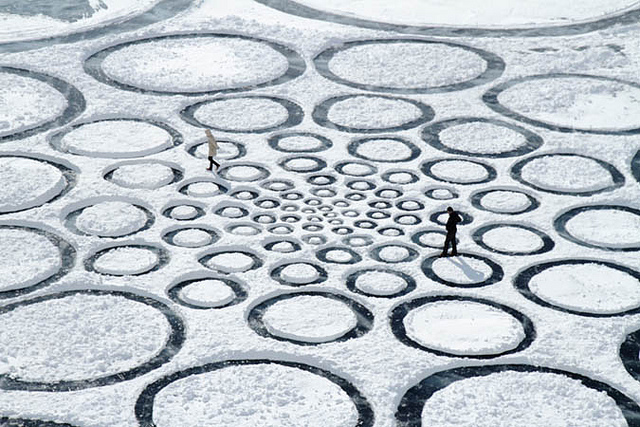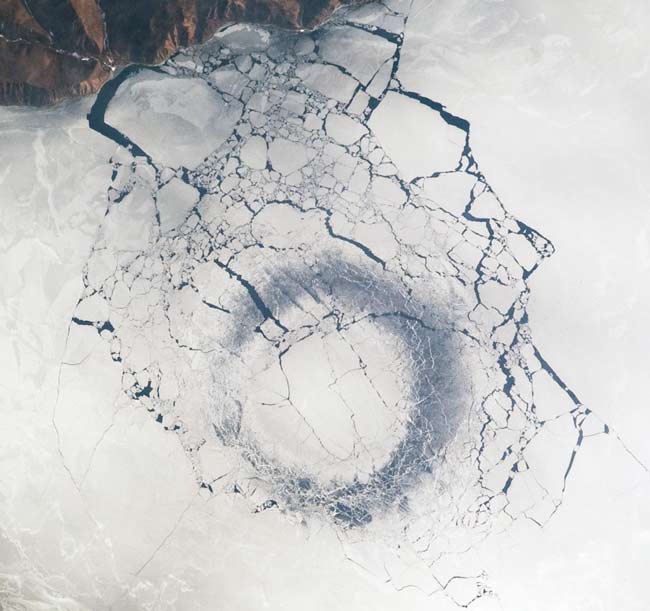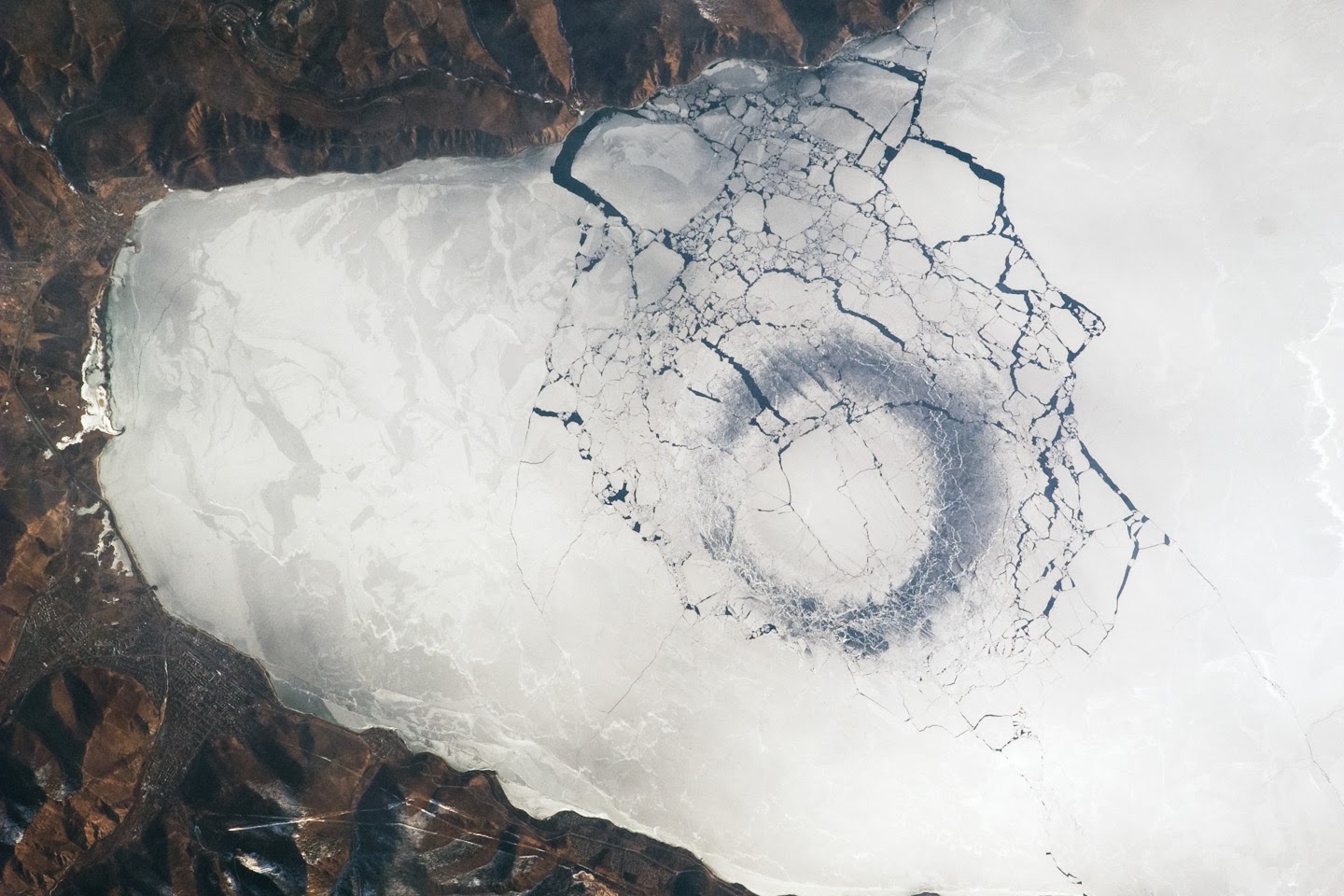|
Geo Art |
|
On
Lake Baikal
An Artist Created the Biggest Drawing in the World The world's largest picture.  On the surface of the frozen Lake Baikal landscape artist Jim Denevan and his team drew the biggest drawing in the world - said "Live Angarsk." The length of the unusual and very beautiful figure - 33 square kilometers, and is the 4469 football fields. This pattern 49-year-old Jim created a working day and night, for 15 days on the surface of Lake Baikal for advertising series "anthropologist" commissioned by the company "Anthropology." To create a drawing, the artist gets in frozen black ice under the snow, which was used as canvas, and the circles made by a plow and spade for the smallest circles. Team of the artist helped paint on a giant figure with a stick, driving on a bicycle.  Template patterning Jim Denevan borrowed from the mathematical Fibonacci curve that contains more than a thousand separate communities. All the time of drawing by Jim and his team lived in a yurt, which is located next to the frozen surface. It is the largest figure in the world and exceeds all previous records, including the last biggest drawing in the world, located in the desert of Nevada, USA, which has now turned out to be 10 percent less than the figure at Lake Baikal. Translated from Russian News of the World Archaeology |
|
Astronauts on board the
International Space Station (ISS) have spotted two
mysterious 2.5mile wide dark circles in the ice of
Russia's Lake Baikal in April 2009. Some aspects of
“odd blemishes” that the astronauts noticed in April
2009 defy explanation and hence mysterious.
The circles on Baikal’s ice are not a new phenomenon obviously. Because of the huge size, it is practically impossible to see a ring standing on the ice or even from a mountain. The Russian government has ordered daily space monitoring of the Lake Baikal area in recent years, which prompted many of the satellite sightings. According to observations,
circle structures do not appear on Baikal’s ice
every year. They were first discovered in 1999, then
in 2003 and 2005. They mostly appear in April and
change their location every time as compared with
previous years. Now they were spotted at the
southern edge of the lake while another was seen
near the centre.
According to scientists, the two circles are the focal points for ice break-up, and may have been caused by methane emissions which created “upwelling” of warmer water that begins swirling in a circular pattern because of the Coriolis force. "Once the water mass reaches the underside of the ice on the surface of the lake, the warm water melts the ice in a ring shape," said Marianne Moore, a marine ecologist at Wellesley College in Massachusetts who has spent much time studying Lake Baikal with Russian researchers. The dark color of the circles is the result of thinning of the ice, which usually happens into June. Upwelling, the scientists say, is not unusual in some relatively shallow areas of the lake where hydrothermal activity has been detected, such as where the circle near the centre of the lake is located. The interesting thing is that Lake Baikal is the largest (by volume) and deepest (5,400ft) fresh water lake on Earth. It is also one of the world’s oldest lakes aged between 25 to 30million years old. Sediment deposited on the bottom is up to 4.3miles deep. The lake contains rare fresh water seals and several species of fish found nowhere else on the planet. SOURCE |
|
By Jeremy Hsu
| June 01, 2009
 Late
in April 2009, astronauts aboard the
International Space Station observed a
strange circular area of thinned ice in the
southern end of Lake Baikal in southern
Siberia. The ice ring had a diameter of 2.7
miles (4.4 km). Credit: NASA
Strange circles have once again appeared in the frozen surface of Lake Baikal in Siberia, as spotted by astronauts aboard the International Space Station this April. News reports described the ice rings as a puzzling phenomenon. But experts say they can explain the mystery, and it's not aliens — methane gas rising from the lake floor represents the likely culprit. Methane emissions can create a rising mass of warm water that begins swirling in a circular pattern because of the Coriolis force, or the phenomenon caused by the Earth's rotation that also helps create cyclones. "Once the water mass reaches the underside of the ice on the surface of the lake, the warm water melts the ice in a ring shape," said Marianne Moore, a marine ecologist at Wellesley College in Massachusetts who has spent much time studying Lake Baikal with Russian researchers. The lake is the largest (by volume) and deepest fresh water lake on Earth. The latest ring patterns included a circle of thin ice with a diameter of 2.7 miles (4.4 km), although the circular patch was becoming a hole of open water. Astronauts spotted similar ice circles in both 1985 and 1994, and satellites have also made sightings over the past years. This phenomenon is nothing new to the Russian government, which has documented circle sightings on an official Ministry of Natural Resources Web site. "Interestingly, the government is also warning people that abnormally high emissions of methane may occur in these areas in the summer and fall, posing risks for ships," Moore told LiveScience. The Russian Ministry of Natural Resources points out that random emissions of natural gas have probably always occurred in Lake Baikal. And such emissions would have created ice rings every few years. "But, because of the huge size, it is practically impossible to see a ring standing on the ice or even from a mountain," the Ministry Web site notes. The Russian government has ordered daily space monitoring of the Lake Baikal area in recent years, which prompted many of the satellite sightings. Tectonic activity deep in the Earth may be the trigger for such methane gas release, according to the Russian government. That could have major consequences for Lake Baikal's rich array of plants and animals, Moore cautioned — especially in combination with a warming climate. Both could lead to spring ice disappearing more rapidly from Lake Baikal, which can typically hold onto an ice cover through June. "Unlike other lakes in the world, spring ice is essential for the reproduction of the lake's top predator (the Baikal seal) and the dominant plants (under-ice phytoplankton) at the bottom of the foodweb," Moore said. "Without spring ice, the food web of this lake will be disrupted substantially." SOURCE |
| FAIR USE NOTICE: This page contains copyrighted material the use of which has not been specifically authorized by the copyright owner. Pegasus Research Consortium distributes this material without profit to those who have expressed a prior interest in receiving the included information for research and educational purposes. We believe this constitutes a fair use of any such copyrighted material as provided for in 17 U.S.C § 107. If you wish to use copyrighted material from this site for purposes of your own that go beyond fair use, you must obtain permission from the copyright owner. |
|
|


